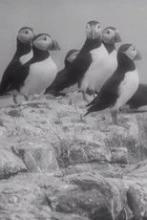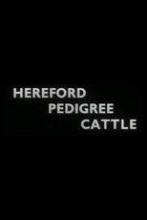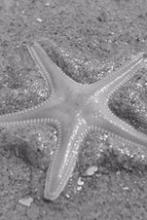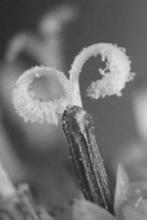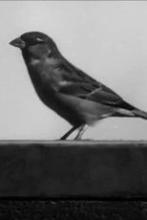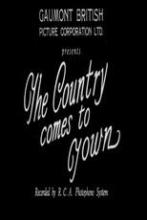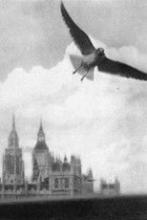
Secrets of Life
The sequel series of shorts to Secrets of Nature (1922-1934).
The Tough 'un (1938)
01 January, 1938
"If they were as rare as orchids we would probably rave about them" opens this film in the Secrets of Nature series, directed by the prolific Mary Field. The mesmerising time-lapse photography is offset by a jokey commentary voiced by EVH Emmett, then best known as the voice of the Gaumont newsreel. The flippant tone is exemplified by his comment on the range of responses to dandelions: "Some gardeners tear up the lawn and lay crazy paving, some tear up a high cliff and jump off".
Nursery Island (1936)
01 January, 1936
The birdlife of Northumberland's Farne Islands comes under the spotlight.
He Would a-Wooing Go (1936)
10 June, 1936
Mary Field and F Percy Smith create this whimsical look at the breeding habits and life cycle of frogs.
Kings in Exile (1938)
01 January, 1938
King Penguins are first seen in their natural habitat, the Antarctic, after which we see them in the Edinburgh Zoo. With slow-motion pictures we see how they swim with the use of their flippers and feet. Their mating and incubating of their eggs and later, the hatching of them; the rearing of the young at various stages of their growth are also shown.
The Catch of the Season (1937)
01 June, 1937
The lifecycle of a freshwater trout; looking in detail at the development of a trout embryo and hatchling. Also shows the techniques involved in dry-fly trout fishing. (NFA Catalogue) Life cycle and habits of the trout. Photographed by Percy Smith. (Synopsis)
Once We Were Four (1942)
01 January, 1942
The Secrets of Life series (1934-50) may not conform to modern expectations of nature filmmaking, inclined as it is towards giving cute fluffy creatures human names and characteristics. But it couldn't be accused of shielding kiddies from the harsher realities of the food chain, as this exercise in ruthless Darwinism demonstrates to unintentionally hilarious effect. A more than usually eccentric narrator introduces us to the newborn bunny quartet of Donald, James, Charles and Clifford, but as the film's title gives away, "the boys" aren't all long for this world as they face an assault course of hungry owls, predatory badgers, shotgun-happy gardeners and aerial bombardment (no harm in a little anti-Nazi detour, this is 1942 after all). (from https://player.bfi.org.uk/film/watch-once-we-were-four-1942/)
Wisdom of the Wild (1940)
01 January, 1940
Part of BFI boxset Ration Books and Rabbit Pies: Films from the Home Front.
Hereford Pedigree Cattle (1937)
01 January, 1937
Short documentary on how cows and bulls are selected for breeding and selling.
Ebb-tide (1936)
01 January, 1936
Go with the flow: to gentle but spellbinding effect this innovative natural history film glimpses marine life astride rising tides at Millport on the Isle of Cumbrae. Urchins, lugworm, weaver-fish and crabs are the shy-but-elegant stars coaxed onto the screen (with the assistance of Millport’s local research station) for this archetypal edition of Gaumont-British Instructional’s 1930s cinema series Secrets of Life.
Fresh As a Daisy (1945)
01 March, 1945
A retired Major's efforts to hone his golf skills are thwarted by the diminutive but defiant common daisy.
Sally the Sparrow (1945)
01 January, 1945
Explore London Zoo with one of its greediest residents, Sally the sparrow.
Seashores (1940)
01 January, 1940
On the search for weird and amazing creatures living on the seashores... This short movie played before The Thief of Bagdad (1940) during its original run in the cinema.
The Country Comes to Town (1933)
31 December, 1933
A celebration of the importance of the British countryside.
The Warblers (1934)
01 January, 1934
This short ends with a warning that the birds helped "to preserve the leafy loveliness of our English countryside. We should therefore protect the warblers."
Perky Cockney (1937)
01 January, 1937
The perky Cockneys are London sparrows, who star in this natural history film.
Memories (1944)
01 January, 1944
History - and natural history - filmed on location in Selborne, East Hampshire. This unusual edition of the long-running series Secrets of Life tells the story of the village's famous son, Rev Gilbert White, whose 1789 book The Natural History and Antiquities of Selborne is a classic of natural history. The film follows in his footsteps, with camera rather than quill in hand, focusing on nature but also taking in views of the village and its human inhabitants. The ingenious close coverage of bird, reptile and other wildlife was the stock-in-trade of the filmmakers at Gaumont-British Instructional, producers of the series. Under the direction of the redoubtable Mary Field, the behind-screen talent here includes legendary 'cine-biologists' Percy Smith and Oliver Pike. A tribute by one generation of pioneering naturalists to another, it's a quietly moving film in spite of its clipped English reserve - or perhaps partly because of it.
London Visitors (1936)
01 January, 1936
The film tkes us to the North of England to follow the migration of the black-headed gull down to London. There, the narrator asks viewers to "listen to their gossip", before demonstrating the bird’s flight in slow motion. We see a polecat feasting on gull eggs, and then a man collecting the eggs for human consumption, with the film telling us that they are considered a “delicacy” in London. Indeed, according to the British Trust for Ornithology, around 300,000 gull’s eggs were sold every year in Leadenhall Market in London during the 1930s, when London Visitors was made.

